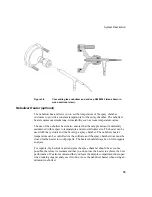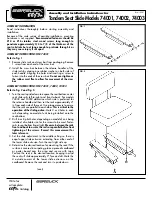
System Description
80
Peristaltic Pump
The peristaltic pump is fully computer-controlled. As an added feature, the pump
speed can be programmed to run at a fast speed for the read or rinse cycle. The
TubingSaver mode is a feature for extending the life span of pump tubing.
Autosampler
PerkinElmer offers autosamplers for automated sample handling. These
autosamplers consist of a sample table, a sample tray, and a motorized sampling arm
with an attached probe. Different sample trays are available for each autosampler,
covering a variety of sample volume and total sample capacity requirements. All
sample trays have one location for a 150-mL wash vessel.
Switches and Controls
Main On/Off Switch
The Main Instrument switch is used to turn on the spectrometer (and is normally left
on). Once the plasma has been ignited, you should wait one half hour for the system
to stabilize before running samples.
Interlocks
Interlocks are designed to ensure operator safety and protect the instrument from
damage. The main system interlocks are described below.
The following interlocks must be satisfied in order to ignite the plasma. If any of
these interlocks is interrupted while the plasma is on, the plasma will automatically
be shut down. Before you can ignite the plasma:
•
The torch compartment door must be closed;
•
the Emergency Off (EMO) switch on front of instrument must be released;
•
the argon pressure for the torch must be correct;
•
the cooling water must be flowing to the plasma induction plates and oscillator;
•
the torch must be installed;
•
the shear gas pressure must be correct.
Summary of Contents for OPTIMA 8000
Page 1: ...OPTIMA 8000 Customer Hardware and Service Guide ICP OPTICAL EMISSION Return to Document Menu...
Page 2: ......
Page 3: ...Optima 8000 Customer Hardware and Service Manual...
Page 12: ...Contents 10...
Page 18: ...16 Indicates the ON position of the main power switch Indicates alternating current...
Page 24: ...22 Figure C Location of warning labels in the sample compartment 1 2...
Page 28: ...26...
Page 29: ...Safety Practices 1...
Page 49: ...Preparing Your Laboratory 2...
Page 61: ...Preparing Your Laboratory 60...
Page 62: ...System Description 3...
Page 89: ...Installation 4...
Page 136: ...Maintenance 5...
Page 241: ...Troubleshooting 6...
Page 264: ...Error Messages 7...
Page 284: ......
















































